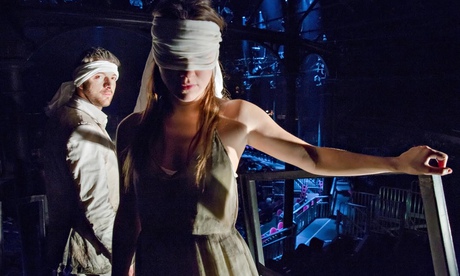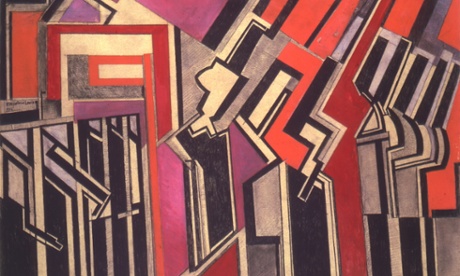Last year Tate Modern successfully reawakened interest in the Russian suprematist Kazimir Malevich. This year the Whitechapel Gallery kick-starts a groundbreaking exhibition of 100 years of geometric abstraction, Adventures of the Black Square, with an allusion to Malevich’s famous work, first shown in 1915. A neat reference in the catalogue to “the censoring silence of the black square” reminds us that Malevich’s tabula rasa cut artists off from the past and made urgent the new. During the revolutionary period, radical experiments with abstraction fed into utopian ideals and communicated political goals, most famously in El Lissitzky’s abstract poster Beat the Whites with the Red Wedge (1919-20). Certainly the Russian heritage is a major ingredient in this particular vein of modernism, which was made richer by the example of the Bauhaus. But geometric abstraction, with its play on modular units and grids, has proved to have vital relevance to the modern world and its accelerated programme of industrialisation and electrification. A curiously adaptive language, pliant and playful, it rarely stands still. In the Whitechapel exhibition it filters through international magazines, infiltrates photography, and percolates into the routine and everyday. With protean fertility, it shimmies up to capitalism and loses its anti-bourgeois stance, only to regain an element of protest as its shape-shifting reputation moves towards the elegiac and ironic.
Yet the exhibition is aptly titled: echoes of Malevich’s Black Square continue to reappear. Openly recreated in Rosemarie Trockel’s knitted picture Cogito ergo sum (1999), its presence also lies behind the painting by the language-based artist Jenny Holzer, Top Secret 32 (2010), inspired by a heavily redacted government document. We confront it again in the lead squares beneath our feet as we walk over Carl Andre’s 10 x 10 Altstadt Lead Square (1967). And it sets a precedent for the red square in Piet Mondrian’s Composition with Yellow, Blue and Red (1937-42), which sits at the heart of this exhibition, upholding high modernism and geometric abstraction at their most sophisticated. Mondrian has here moved on from Malevich’s foundational square, yet his search for “dynamic equilibrium” similarly recognises the human hunger for the absolute and immutable, created by the relativity and mutability in things.
It is worth mentioning here that Mondrian introduced two red squares into the Abstract & Concrete exhibition, held in London in 1936. This was the first international exhibition of abstract art in Britain. Only after Abstract and Concrete was on the road, opening in Oxford and heading for Liverpool and Cambridge, did a London gallery express interest in showing it. It was, after all, said to be, by the Daily Mail, “at best, a jolly leg pull”; and even Christie’s, who should by this date have known better, were prepared to testify, for the purpose of customs and insurance, that the exhibits – including those by Calder, Gabo, Kandinsky, Giacometti and Miró – were almost worthless in terms of monetary value. Mondrian, who never enjoyed commercial success in his own lifetime, showed three paintings, each for sale at £50. Neither the Tate nor the Contemporary Art Society wanted them, and the two that sold went to the exhibition organiser Nicolete Gray and her friend, the patron and collector Helen Sutherland.
This resistance to abstract art is on the whole ignored by the Whitechapel’s upbeat take on the history of geometric abstraction. But it is, in part, what makes its achievement heroic. And the story of how Gray came to mount Abstract & Concrete is telling. A good chunk of her childhood had been spent in one of the six houses that then formed part of the British Museum, where her father, Laurence Binyon, worked in the Print Room. In the course of his 40 years at the museum, Binyon became a leading authority on the art of India, Persia, China and Japan. Gray often spent Saturday mornings and Sunday afternoons in his company, visiting exhibitions. Later she recognised that familiarity with non-European art gave her insight into the work of her contemporaries, and that Chinese art, in particular, had presented her with a key to abstraction.
Perhaps it is the habitual resistance to abstract art among the English that has limited the British presence in the Whitechapel show. There is no work by Marlow Moss, Bridget Riley, Jean Spencer or Gina Burdass, nor any image of high-rise flats by David Hepher. Missing in the section on magazines is Myfanwy Evans’s Axis, which inspired Gray and was arguably the most avant garde and international art magazine published in England in the 1930s; and the influence of Jan Tschichold is clearly visible in its cover, designed by John Piper.
But the strengths of this show outweigh the omissions. The four main themes – Utopia, Architectonics, Communication and the Everyday – are well chosen. All emphasise how the emptiness of the Black Square led to the imagining of new tomorrows – most notably in the Architectonics section where geometric abstraction, conceived in three dimensions, explores the built environment and the concept of social space. Malevich himself made models of ideal cities and buildings, which his friend Lissitzky published in numerous European publications. There was also a desire to marry the aesthetics of abstraction with interior decoration, as shown here in Theo van Doesburg’s design for a small bathroom conversion for the Cafe Aubette in Strasbourg (1926-27). We are reminded also of Mondrian’s search for a harmonious whole, each time he set up a new studio-home, an endeavour brilliantly illustrated and analysed in last year’s exhibition Mondrian and his Studios, mounted by Tate Liverpool in collaboration with Michael White.
Magazines spread ideas about the fusion of art, architecture and life, and they rightly make a strong showing in the Communications section. They did much to uphold the visual rigour associated with geometric abstraction, and helped promote the “constructivist idea in art”, identified by Naum Gabo and others. “Concrete” became a buzzword. As Max Bill explained: “We call ‘concrete art’ those artworks that emerged on the basis of their very own means and rules – without extrinsic reference to natural appearances or their transformation … concrete art in its final consequence is the pure expression of harmonious measurement and law.”
Having trained at the Bauhaus and taken much from Van Doesburg’s “Concrete Art Manifesto” (1930), Bill stood for clarity of design in painting, industrial design, architecture and writing. Although Swiss by birth, and the founder of the Allianz group of Swiss concrete artists, he taught in various cities and had a major influence on Latin American artists, notably in Brazil where his ideas fused with the ambitions and utopian modernism of the country following the second world war. Once again, in the mid-20th century, geometric abstraction and social relevance went hand in hand. Yet pioneers of concrete art in Brazil, such as Lygia Clark and Waldemar Cordeiro, are still little known in this country and their presence in the Whitechapel show adds to its interest.
By the 1960s the political heft behind geometric abstraction had lessened and it leaned more to the conceptual and performative. In 1968, Daniel Buren orchestrated an act of resistance against capitalism by means of his signature stripes, which appeared on placards and banners and were painted over advertisements, as a form of guerrilla tactics. But now abstract art rested on a symbiotic relationship with the everyday and lacked the radicalism of Malevich’s square. Buren rightly argues: “Every act is political and, whether one is conscious of it or not, the presentation of one’s work is no exception. Any production, any work of art is social, has a political significance.” Which is why everything in this show, from Liam Gillick’s deliberately impersonal collaborations, through Fernand Léger’s film exploring the mechanisation of daily life Le ballet mécanique, to Anni Albers’s hand-crafted tapestry, has point and edge.
• Adventures of the Black Square: Abstract Art and Society 1915-2015 is at the Whitechapel Gallery, London E1, from Thursday until 6 April.











